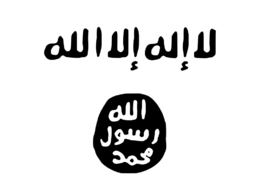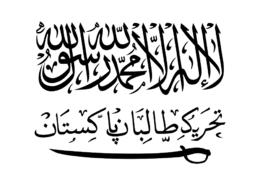Pakistani Taliban facts for kids
Quick facts for kids Tehreek-i-Taliban Pakistan |
|
|---|---|
| تحریک طالبان پاکستان Pakistani Taliban Movement Participant in Global War on Terrorism, Insurgency in Khyber Pakhtunkhwa, War in Afghanistan (2001–2021) |
|
  Top Left: Current Logo of Tehrik-i-Taliban Pakistan (2024–present) Top Right: Former Logo of Tehrik-i-Taliban Pakistan (2020–2024) Bottom Center: Former Logo of Tehrik-i-Taliban Pakistan (2018–2020)   Top: Current Flag of the Tehrik-i-Taliban Pakistan (2018–present) Bottom: Former Flag of the Tehrik-i-Taliban Pakistan (Until 2018) |
|
| Active | December 2007 – present |
| Ideology | Deobandi Islamic fundamentalism Pashtunwali Sectarianism Separatism |
| Motives | Fundamentalism Pashtunwali Deobandi Sectarianism Separatism |
| Allegiance | |
| Leaders | |
| Headquarters | Eastern Afghanistan |
| Allies |
|
| Opponents | |
| Designated as a terrorist organisation by | |
The Pakistani Taliban (Urdu: پاکستانی طالبان), officially known as the Tehreek-e-Taliban-e-Pakistan (تحریکِ طالبان پاکستان, meaning Pakistani Taliban Movement, or TTP), is a group of different armed groups working together. They operate near the border between Afghanistan and Pakistan.
This group was started in 2007 by Baitullah Mehsud. Its current leader is Noor Wali Mehsud. The Pakistani Taliban share similar ideas with the Afghan Taliban. They even helped the Afghan Taliban during the war from 2001 to 2021. However, these two groups operate separately.
Most Taliban groups in Pakistan are part of the TTP. A main goal of the TTP is to go against the Pakistani government. They try to overthrow the government by attacking the Pakistani armed forces and the state. The TTP gets its members from the tribal areas along the Afghanistan–Pakistan border. They also get ideas and support from al-Qaeda.
After the Pakistani military took action in Khyber Pakhtunkhwa, some TTP members went from Pakistan to Afghanistan. Some of them joined another group called Islamic State – Khorasan Province. Others stayed with the TTP. In 2019, reports from the United States Department of Defense said there were about 3,000 to 4,000 TTP members in Afghanistan. Between July and November 2020, several smaller groups joined the TTP. This made the TTP stronger and led to more attacks.
In 2020, after some disagreements, the TTP became more organized under Noor Wali Mehsud. Mehsud has tried to change the group's image. He ordered attacks only on security and law enforcement, trying to avoid harming regular people. This was an effort to make the group seem less extreme than others, like the Islamic State.
After the Afghan Taliban took control of Afghanistan in August 2021, Pakistan tried to get them to control the TTP. Instead, the Afghan Taliban helped arrange talks between Pakistan and the TTP. This led to the release of many TTP prisoners in Pakistan. It also resulted in a temporary ceasefire, which is a pause in fighting. After this ceasefire ended on December 10, 2021, the TTP increased its attacks on Pakistani security forces. These attacks came from safe places inside Afghanistan. In response, Pakistan carried out airstrikes in Afghanistan's Khost and Kunar provinces on April 16, 2022.
Why TTP is Called a Terrorist Group
Many countries and organizations consider the TTP a terrorist group. This means they see the TTP's actions as harmful and dangerous.
- On September 1, 2010, the United States officially called the TTP a Foreign Terrorist Organization (FTO). This makes it illegal to support the group or do business with them. It also allows the U.S. to freeze any money or property the group might have. The U.S. also offered a reward for information about two of its leaders at the time.
- In January 2011, the United Kingdom also banned the TTP under its Terrorism Act 2000.
- In July 2011, Canada added the TTP to its list of banned terrorist groups as well.
- Other countries and organizations that have named the TTP as a terrorist group include Argentina, Bahrain, Japan, New Zealand, United Arab Emirates, Pakistan, and the United Nations.
How the TTP is Organized
The TTP is different from the Afghan Taliban in its structure. It's more like a loose group of many smaller armed groups. These groups are united by their shared dislike for the central government in Islamabad, Pakistan.
Experts describe the TTP as a network of different groups. These groups vary in size and how much they work together. Often, these smaller groups mostly operate in their own local areas. They might not be able to expand their actions beyond those areas.
When the TTP first started, Baitullah Mehsud was its main leader, called the amir. Hafiz Gul Bahadur was the second-in-command, known as naib amir. Faqir Mohammed was also a very important leader. The group had members from many tribal areas and districts in Pakistan. In 2008, some thought the group had about 30,000 to 35,000 members, but it's hard to know for sure.
Who Leads the TTP Now
- Noor Wali Mehsud (also known as Abu Mansoor Asim) – He is the main chief, or Emir, of the Tehrik-i-Taliban Pakistan.
- Muzahim (also known as Mufti Hazrat) – He is the deputy chief, or Naib emir, of the TTP.
- Hafiz Gul Bahadur – He leads a strong group in North Waziristan.
- Aleem Khan Khushali – He leads a group active in North Waziristan.
- Muhammad Khurasani – He is the main spokesperson for the TTP.

